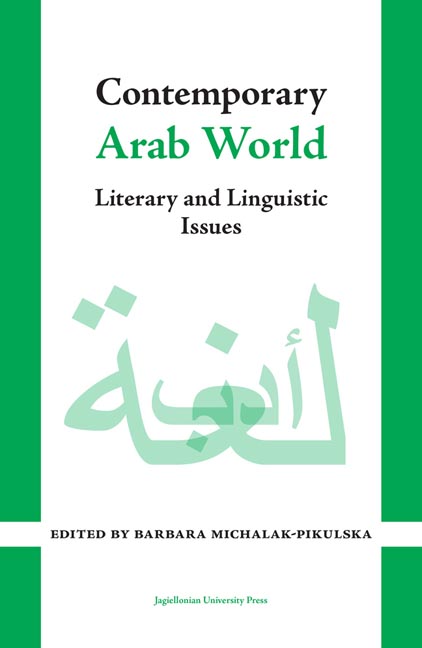Book contents
- Frontmatter
- Contents
- Introduction
- Between past achievements and future challenges Arabic language teaching at the university level – example of the Department of Arabic Studies at the Jagiellonian University in Cracow
- Meanings and functions of genitive constructions in Modern Standard Arabic
- Sultan Qaboos – image of the ruler in panegyrics and elegies by Omani poets
- Microfiction, flash fiction or very short story in modern Arabic literature
- In the maze of discourses – monodrama Bāy bāy Ğīllū (Bye Bye Gillo) by Ṭaha ‘Adnān
- Women in Islamic State propaganda
- Annex
Between past achievements and future challenges Arabic language teaching at the university level – example of the Department of Arabic Studies at the Jagiellonian University in Cracow
Published online by Cambridge University Press: 14 October 2023
- Frontmatter
- Contents
- Introduction
- Between past achievements and future challenges Arabic language teaching at the university level – example of the Department of Arabic Studies at the Jagiellonian University in Cracow
- Meanings and functions of genitive constructions in Modern Standard Arabic
- Sultan Qaboos – image of the ruler in panegyrics and elegies by Omani poets
- Microfiction, flash fiction or very short story in modern Arabic literature
- In the maze of discourses – monodrama Bāy bāy Ğīllū (Bye Bye Gillo) by Ṭaha ‘Adnān
- Women in Islamic State propaganda
- Annex
Summary
Introduction
Teaching Arabic as a foreign language is connected with numerous methodology related challenges, and most of them result from the specificity and complexity of the socio-linguistic situation in the Arab world. However, methodology related problems, which remain an open issue and leave the door wide open for discussion, are not the only dilemmas that university level language teaching is facing nowadays. The needs and expectations of learners are changing. The view on the broadly understood sense of higher education and the value of education itself are changing. The teaching market is changing. What are the problems that teaching Arabic at 21st century universities has to face? What are the challenges we are facing and what new windows can be open for higher education?
The issue of legal frameworks, which also play an important role in the teaching process at academic level, is raised very rarely in these debates. Despite some degree of autonomy, which results from the extensive statutory rights of the universities as entities, language education at universities is part of formal education and as such it is subject to strict normative rules, resulting from national and international legal acts, which in turn are a derivative of general education policy. This aspect of teaching is highlighted in the article written by Jerzy Łacina, defining it as so-called “supervisor's expectations”, which can significantly affect the didactic process. This issue will also appear many times in the considerations presented here about the realities of teaching Arabic language in Poland.
The beginnings of European Arabist research go back to the 11th century and are closely related to translation activities. Probably also in the middle of the 12th century the translation schools were operating in Toledo. The first chairs of Arabic began to arise in the 16th century – in 1538 François I founded a chair in Arabic at the Collège royal in Paris, in 1599 a chair in Arabic at Leiden University was established. However in Poland, for many decades the interest in Arab culture was informal and was inspired – as can be easily guessed – somehow by pragmatic reasons. Among the enthusiasts of the Eastern world there were, among others: travelers, politicians or experts in various fields which were unrelated to philology, such as doctors, whose written testimonials have undoubtedly enriched the Polish intellectual heritage, although they were not of a scientific nature except for a few examples.
- Type
- Chapter
- Information
- Contemporary Arab WorldLiterary and Linguistic Issues, pp. 11 - 30Publisher: Jagiellonian University PressPrint publication year: 2020

